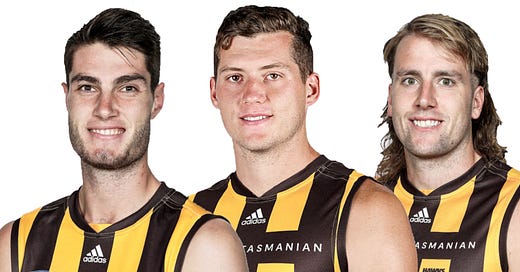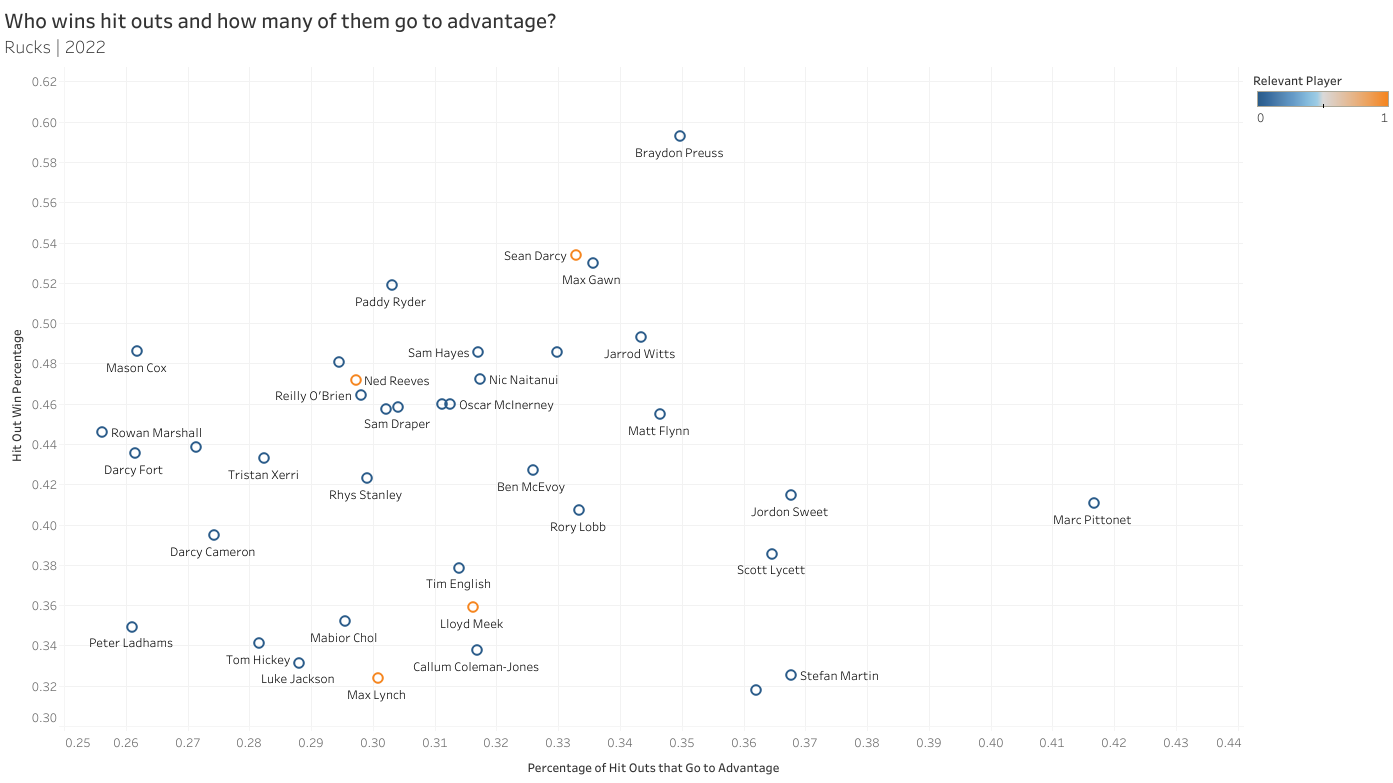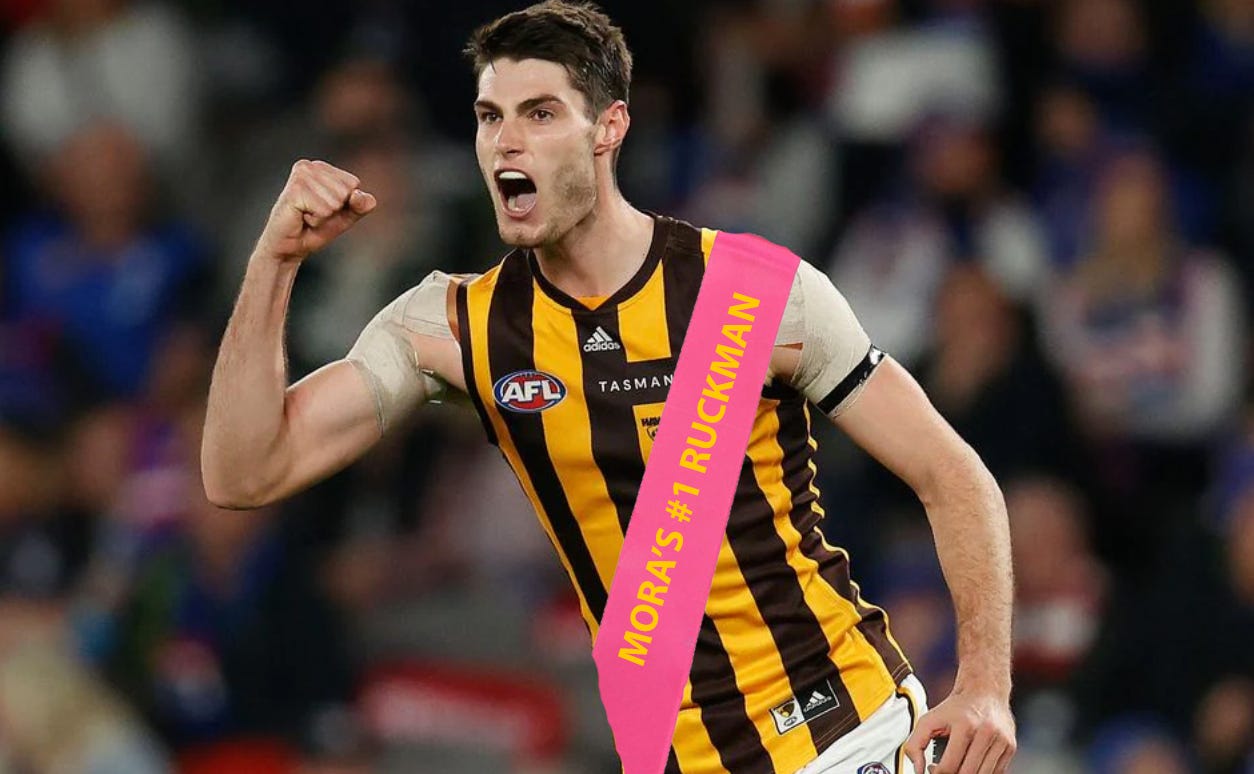Number crunching: Who is the No.1 ruck?
In the first of an occasional series, Simon Morawetz analyses the data to establish who should take the opening bounce against the Bombers.
Hawthorn enters 2023 as one of the few teams where the number one ruck spot is up for grabs.
Whereas the name of most clubs’ No.1 ruckman is written on the whiteboard in permanent marker, the Hawks have a three-way challenge for it, with Ned Reeves, Lloyd Meek, and Max Lynch set to drive each other to greater heights.
So who should it be? Reeves is the incumbent, while Lynch was solid in between his repeated bouts of misfortune. The addition of Meek has only muddied the waters further. In this column, I will examine the trio’s body of work to see if the data can shed any light on the situation.
Before anything, it would be worth saying a word about Sean Darcy. Freo’s first-string ruckman is fast becoming one of the league’s best.
He uses his size and strength to great effect, and his ruckwork (by the numbers) was comparable to Max Gawn’s last year. What’s more, he won Fremantle’s Best & Fairest in 2021, at the age of 23, so you know the coaching staff really rate him.
So that is who Meek has been stuck behind, and a large reason that he’s only played 15 games (our most experienced ruck, Reeves, has played 17).
Does he have what it takes to make his way into the centre square for the first bounce of 2023? Let’s crunch the numbers (sourced from AFL Stats Pro) and see if they can shed any light.
First of all, and this sounds so obvious that it’s almost painful to write, but it must be said: the first thing to assess when considering rucks is ruck-work.
RUCK-WORK
The following chart shows the AFL’s rucks in 2022, ranked for hit out wins (hit outs per ruck contest) against the proportion of those hit outs that go to advantage (HTAs).
For this exercise, I’ve only considered rucks who attended 200 or more ruck contests. The players who attended between 100 and 200 contests are key forwards, rucks who didn’t play many games, and Conor Nash.
I’ve highlighted our three rucks on the chart in orange, as well as Darcy.
I should note that there are some limitations to the data I have. For example, I would love to be able to drill down into greater detail – such as which individuals were at a contest – but the AFL Stats Pro data is only at a high level. I would also like more detail than just whether a hit-out went to advantage or not: how many of the not-to-advantage taps go straight to the opposition? That’s a relevant detail that is missing here.
But working with what I have, this is what we can find.
One thing that stands out immediately is former Hawk Marc Pittonet’s extraordinary HTA percentage, but that’s another story.
What stands out relevantly is that Reeves wins a hit out in a very high proportion of contests. Only nine rucks have a better percentage in this space. This is probably to be expected given his height – it’s not a coincidence that Gawn, Witts, Cox, and Preuss are up there too – but that doesn’t make that fact any less material.
Meanwhile, Meek has the highest proportion of HTAs. His ratio was better than the likes of Brodie Grundy, Tim English, and Todd Goldstein, and virtually level with Nic Naitanui.
Which raises the question: do you want more hit outs, or higher quality hit outs?
I am inclined to lean towards Reeves in this space. Firstly, winning HTAs is something you can improve on. With Reeves, the first half of the job is easily won; I believe the second half will improve with experience. Building connection with your midfield doesn’t happen overnight.
Secondly, it is worth noting that Darcy played in three of Meek’s six games this season. That means Meek would have often contested against the opposition’s relief ruck. It must also be said he had better midfielders at his feet. Both of those factors might inflate his HTA percentage.
So when it comes to ruckwork, I award the points to Reeves.
But beyond ruckwork, it’s also important to assess what the players offer after the hit-out is contested.
CLEARANCE WORK
Immediately, that relates to clearance work. Further from the contest, that includes being able to take a contested mark, particularly when resting in the forward line.
Clearly, Meek is our best performer when it comes to winning clearances himself. It could be because he takes the ball out of the ruck more, or because of better second efforts once the ball hits the ground. Whatever the reason, it’s clear Reeves and Lynch are behind not just Meek, but most of the league in this regard.
MARKING
Where Reeves and Lynch have their new colleague covered is in marking.
Meek took just three contested marks in his six games last year, and only one mark inside 50. By contrast, Reeves took seven CMs and six marks inside 50 in his 11-and-a-quarter games.
Moreover, while Meek kicked two goals (0.33 per game), Reeves snagged seven (0.58). Lynch kicked four in his seven games (0.57). To date, it appears our incumbent duo have provided more of a scoreboard threat; it’s an area Meek needs to improve on.
FINAL SAY
In conclusion, if I’m on Hawthorn’s match committee, I’m giving Ned Reeves first crack at the ruck mantle. His sheer size means we can expect a lot of hit-outs, and it’s fair to expect a ruckman’s HTA percentage to improve after his first 17 games. He also has more experience working with the midfield, which is invaluable.
This is not to discount Lloyd Meek – I do think he can become a very good player, and he will be ready to pounce on a dip in form. Nor Max Lynch, although for mine he is third in the queue.
One thing we can all agree on is that if we do change rucks at some point, it had better be because someone is banging the door down and not because we’ve copped more injuries.












Thanks this is good but the total games for these guys is 32 between them.
Statistically - it is next to impossible to draw conclusions at this stage
We don't know what we have with any of these guys. We need to just play them in blocks of 5 to 6 games and see what happens.
2023 is a learning year.